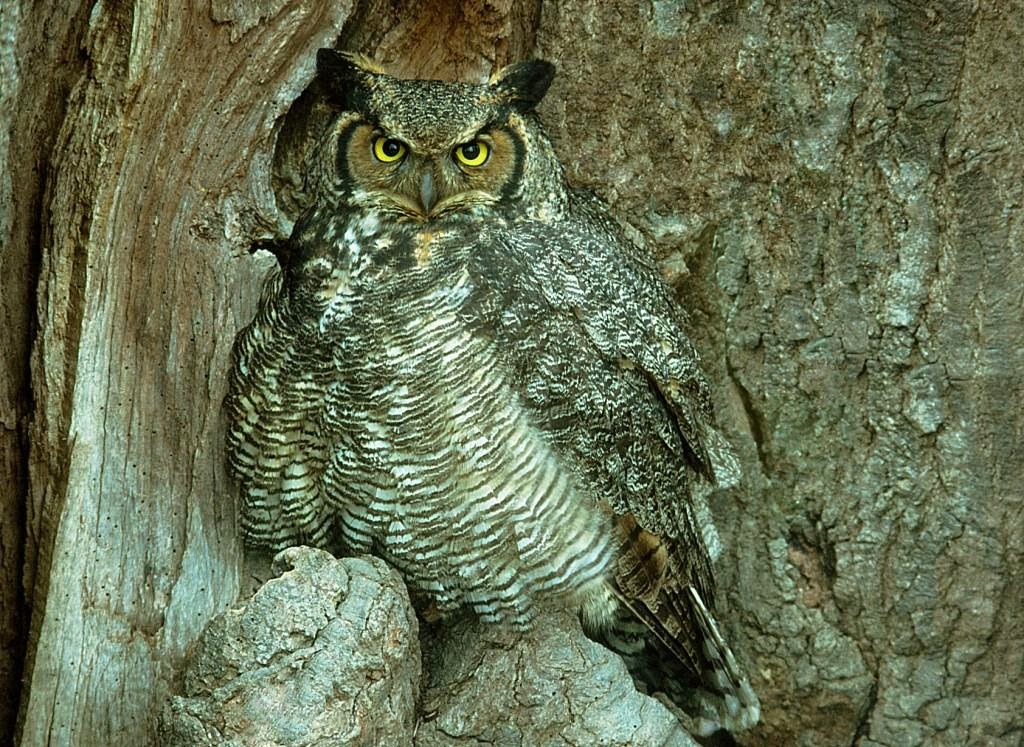Photo: Gary Meszaros
A big female Great Horned Owl stands sentinel at the entrance to her nest site, a broken snag. Gary Meszaros took this photo the other day near Cleveland, and (obviously) gave me permission to share it. This is without doubt one of the coolest images of this species that I've seen. To see more of Gary's work, CLICK HERE.
Great Horned Owls are surprisingly common, and no doubt lurk near you. They are the nocturnal analogs to Red-tailed Hawks, so if you see the latter chances are good the big owls are around, too. In fact, the most common nest site for these owls, in these parts, are the nests of Red-tailed Hawks. If the larger more powerful owls decide to appropriate a hawk nest, tough luck to the rusty-tailed raptor. A distant second regarding nest sites are broken-off tree snags, such as in Gary's photo. A small percentage of owls will modify squirrel drays for nests. A dray is a leafy arboreal nest of tree squirrels. Occasionally an owl pair will commandeer a Great Blue Heron nest, creating an uneasy alliance when the herons return to their rookery.
The big owls commence nesting in the midst of winter. Eggs are commonly laid between mid-January and mid-February, and at least some nests will be full of owlets by now. The downy white owlets grow with startling rapidity, and before long resemble fuzzy grocery sacks. Their parents ply them with all manner of food - Great Horned Owls have the most diverse diet of any of our owls. Even skunks are not off limits.
The Great Horned Owl is one of my favorite birds, and I've amassed a significant body of unforgettable memories involving these "winged tigers" (in the words of Ernest Thompson Seton). Once, while cruising a back road in Ross County in the darkness, I rounded a corner and there was a Great Horned Owl in the middle of the road. It had a freshly killed rabbit. The owl ran me through with its piercing yellow gaze, and refused to leave its kill. Finally, the prey being too much to get airborne, it stumble-flapped its victim up the road bank and into the bush.
Another time, I was passing through the heart of the Ohio State University's campus, at 15th Avenue and High Street, not far from downtown Columbus, when the giant shape of a horned owl whisked ghostlike through the intersection. Some owls are quite the urbanites, and woe to any rat that crosses their path.
Several years ago, a Great Horned Owl nest was discovered mere feet from busy Cleveland Avenue in Columbus. It had appropriated a Red-tailed Hawk nest high in a silver maple on the grounds of St. Ann's Hospital. Word got out, the Columbus Dispatch featured the owl in its pages, and the rush began. The hospital ended up cordoning off a big chunk of parking lot to accommodate the throngs of admirers. Thousands of people must have seen that fierce-looking owl as she sit high above, occasionally deigning to glance down at the assembled rabble with her glaring eyes. In spite of her innate ability to make us feel less than, everyone was thoroughly charmed by the animal.
We've come a long way in our attitudes towards high-end predators such as the Great Horned Owl. It wasn't that long ago that owls and hawks were routinely shot on sight, sometimes to the point of utter elimination. Less than a century ago, it would have been very hard to find a Great Horned Owl in the region where Meszaros made this photo. Nearly all of them had been shot out.
Keep a close eye on hawk and heron nests in your travels. Sooner or later, you'll see the telltale ear tufts of a Great Horned Owl sticking over the top, or the big pieces of white fuzz which are the owlets.
